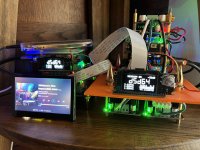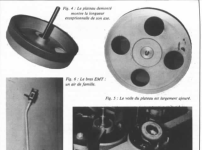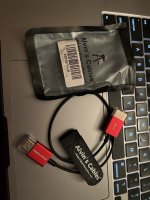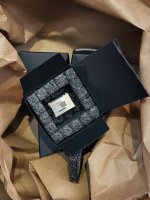Never will go away from balanced....one you do it you can't go back.Hello,
I am using the siver wire autoformers from slagle too in my tube line pre amp.
A few decades ago there was the same discussion why use a pre amp if your cd player gives you more than enough output voltage.
So i am sure the answer is out there.
Having balanced connections is a nice advantage. I remember a meeting with a French diy audio group in the nineties in a real cinema. The chairman of the group did install the sound and vision system in that theatre . We watched a James Bond movie with the best movie sound i ever heard.
After that we played music using a Revox/Studer D730 which was positioned in front of the stage and ALL the other equipment was in the room where the projector was. SO probably minimum of 100 meters balanced interconnect ( Mogami/Prefer/Neglex surely no audiofool brand) and a remarkable good sound.
That was the reason to go for a balanced output on my tube line stage with a pair of Tango output transformers.
In the attachment the loudspeaker system of a French audiophile friend recently deceased and my homebrew tube line amp.
Greetings, eduard
There are a few reasons to use a preamp:
1. Analog volume control
2. Impedance mismatches
3. Gain
4. More than One Source of music that is not digital
5. Change the sound signature
Each of these reasons is system dependent. There is no right or wrong answer. There are many options out there.
Digital volume control is convenient, but depending on implementation it can degrade the sound some.
1. Analog volume control
2. Impedance mismatches
3. Gain
4. More than One Source of music that is not digital
5. Change the sound signature
Each of these reasons is system dependent. There is no right or wrong answer. There are many options out there.
Digital volume control is convenient, but depending on implementation it can degrade the sound some.
All sound reasons. Usually IMHO Impedance matching is the sound quality driver that can't be achieved with a linestage. I use a clean triode output stage on the DAC, so adding another buffer or gainstage seems redundant. I think in the end, trying and listening is the only reliable way to choose.
Back to the original post by Ian. I think he was advocating for balanced cables which IMHO is a solid recommendation. I just put up with the induced noise on singled ended unshielded cables, but balanced cables seems a smart move to remove the cable from the equation.
Back to the original post by Ian. I think he was advocating for balanced cables which IMHO is a solid recommendation. I just put up with the induced noise on singled ended unshielded cables, but balanced cables seems a smart move to remove the cable from the equation.
Hello,
My dddac has an output transformer and has a healthy voltage output.
I know the designer of the Dddac asking the maker of the transformer ( Sowter) to make a similar transformer but with a volume control integrated. Forgot if it is autoformer or if it has two separate windings.
Of course there are real balanced circuits and once that use some kind of trick.
My line pre amp uses a balanced output by using a line output transformer. In the power amp there is a tiny Lundahl transformer ( they call it problem solver ) that changes the balanced output into a single ended input.
They are designed to break ground loops. Normally they come built into a connector but they can be acquired separately.
Greetings,Eduard
My dddac has an output transformer and has a healthy voltage output.
I know the designer of the Dddac asking the maker of the transformer ( Sowter) to make a similar transformer but with a volume control integrated. Forgot if it is autoformer or if it has two separate windings.
Of course there are real balanced circuits and once that use some kind of trick.
My line pre amp uses a balanced output by using a line output transformer. In the power amp there is a tiny Lundahl transformer ( they call it problem solver ) that changes the balanced output into a single ended input.
They are designed to break ground loops. Normally they come built into a connector but they can be acquired separately.
Greetings,Eduard
Hey all, I am working on a case based on the orange plate I made for the DAC Stack in this post
Dual Stacks
Here is a render. I just have the ReceiverPiPro partially modelled. Building the case down from the orange plate and then up with 3D printed custom parts I am making to measure. It will get narrower as it goes up. I have cutouts for monitor Pi Pro in the front and a power switch and at the back the 3 power feeds.

Dual Stacks
Here is a render. I just have the ReceiverPiPro partially modelled. Building the case down from the orange plate and then up with 3D printed custom parts I am making to measure. It will get narrower as it goes up. I have cutouts for monitor Pi Pro in the front and a power switch and at the back the 3 power feeds.
Attachments
I have done so much listening tests with and without a pre amp and me an high quality active pre amp sounds MUCH better than a system with just digital volume control. Highly advise you to listen yourself and decide what you prefer. Only you can decide by doing this as is does not matter what we say other than sharing our experiences. A good HiFi shop will loan you the gear to do this…… enjoy it as good fun and part of the hobbySo for my analogue output board on the ian DAC (dual mono) I built (OPA861), it's giving me 4V out @ 0db (full ESS chip output) at XLR analogue side. So a pre-amp just gives me essentially a volume control to REDUCE the volume (voltage from 4 to something lower than 4V) before handing it to the power amp? Because power amp input voltage is 2-4V.
And I need a good pre-amp to preserve the dynamic range on the pre-amp side to be as close to the digital SNR of the DAC?
So what is benefit of the pre-amp? Isn't it just one more place to degrade the signal? Why not use MonitorPiPro volume control and go straight into a power amp if the OPA861 is able to give power amp input voltages no problem?
I'm such a newbie
View attachment 1214244
I have a Tom Evans The Vibe passive pre with high end PSU which is all single ended and costs a fortune but I rather listen to my system with my Bel Canto Pre 3 with balance signal path. To my ears the Pre 3 is superb and plan to sell the vibe one day.
Thanks Simon. I will do this and see what differences I hear.I have done so much listening tests with and without a pre amp and me an high quality active pre amp sounds MUCH better than a system with just digital volume control. Highly advise you to listen yourself and decide what you prefer. Only you can decide by doing this as is does not matter what we say other than sharing our experiences. A good HiFi shop will loan you the gear to do this…… enjoy it as good fun and part of the hobby
Hello,Hey all, I am working on a case based on the orange plate I made for the DAC Stack in this post
Dual Stacks
Here is a render. I just have the ReceiverPiPro partially modelled. Building the case down from the orange plate and then up with 3D printed custom parts I am making to measure. It will get narrower as it goes up. I have cutouts for monitor Pi Pro in the front and a power switch and at the back the 3 power feeds.
View attachment 1214446
Because you are going to use a 3D printer you might as well use a design principle used for the EMT930 turntable. Usually aluminium platter will sound like a bell when you '' hit '' them with your knuckles. What they did do is put most of the weight on the outside and add 4 big circulair holes.
Because people talking about vibration sensitive clocks using a material and a shape that will kind of absorb vibrations could be a plus.
It could be that two tin layers of a kind of polymer separated by a layer of sand could absorb loads of vibrations. Are clocks sensitive to vibrations in a same way like a turntable?
The Japanese have done experiments with building a loudspeaker enclosure with exactly the same dimensions just completely different materials. Very thick glass sounded very bad , just like concrete, steel. There were no vibrations in the lower frequency range ( below 600 hertz) but above that there were several '' peaks '' showing the vibrations introduced by a technical device were kind of transformed into higher frequencies turning the sound into a very aggressive kind.
Is there a way to determine which kind of vibrations are bad for the clocks.
Making your own housing could have more advantages then we would have hoped for.
Personally i think using 4 spikes to support something with a total weight of 2 kilogrammes is a bit weird. I would use just 3 and create a centre of gravity as low as possible. Because my construction will be inside my DDDAC mainframe i will probably for a kind of suspended construction using springs or some kind of elastic.
Greetings, eduard
Attachments
@eduard Cool. I checked out the DDDac stuff. Brain-bending stuff 
You guys are all so smart. I'm a mad professor. Good idea re the feet. I am also building a turntable (see other thread from me). But Re the DAC, I haven't yet figured out what I will put UNDER the case to support.
I think 3 spring loaded feet are a good idea. I will try this out on the prototype case. Thanks for the idea.
You guys are all so smart. I'm a mad professor. Good idea re the feet. I am also building a turntable (see other thread from me). But Re the DAC, I haven't yet figured out what I will put UNDER the case to support.
I think 3 spring loaded feet are a good idea. I will try this out on the prototype case. Thanks for the idea.
I like the look of the Bel Canto. I need something like this with (1) XLR input, (1) RCA input and XLR out and RCA outs. That's it.I have a Tom Evans The Vibe passive pre with high end PSU which is all single ended and costs a fortune but I rather listen to my system with my Bel Canto Pre 3 with balance signal path. To my ears the Pre 3 is superb and plan to sell the vibe one day.
I have an (1) RCA analogue turntable source my (2) Ian streamer goes into the IAN DAC XLR into the powered speakers XLR right now but maybe future into a preamp. Can a kit give me something quality for half to a third the price?
Everything new I see is essentially pre-amp wise is a DAC/Streamer/Pre-amp all combined for like a high price and probably not as good as separate DAC and Streamer I just built. So that's why I built the Streamer as a component to initially use the DAC as my source selector/pre-amp and put the turntable into my DAC with a separate phono pre-amp to optical out. Like Project Phone Preamp optical out. Right now i use a cheapie thing that does that, until i finish my turntable build.
So for now till I find an old school XLR pre-amp that doesn't cost thousands, I will go pre-amp-less, but try some out for free as you mentioned to see if I even prefer it like that.
I got this nice little 12" flexible HDMI 8K 2.1 cable that seems to be co-axial to connect my IAN streamer stack to my ian DAC stack via i2s...
Anyone else used this type of cable? It's like 1/4 the size of the cable I'm using now. Is it OK for the HDMI i2s connection? Once i get them both in a case ill be able to use a shorter cable.
Anyone else used this type of cable? It's like 1/4 the size of the cable I'm using now. Is it OK for the HDMI i2s connection? Once i get them both in a case ill be able to use a shorter cable.
Attachments
The Pre 3 is now rare and hard to find second hand. Try eBay as they do come up thereI like the look of the Bel Canto. I need something like this with (1) XLR input, (1) RCA input and XLR out and RCA outs. That's it.
I have an (1) RCA analogue turntable source my (2) Ian streamer goes into the IAN DAC XLR into the powered speakers XLR right now but maybe future into a preamp. Can a kit give me something quality for half to a third the price?
Everything new I see is essentially pre-amp wise is a DAC/Streamer/Pre-amp all combined for like a high price and probably not as good as separate DAC and Streamer I just built. So that's why I built the Streamer as a component to initially use the DAC as my source selector/pre-amp and put the turntable into my DAC with a separate phono pre-amp to optical out. Like Project Phone Preamp optical out. Right now i use a cheapie thing that does that, until i finish my turntable build.
So for now till I find an old school XLR pre-amp that doesn't cost thousands, I will go pre-amp-less, but try some out for free as you mentioned to see if I even prefer it like that.
Hi @fusion360guyDual Stacks
Here is a render. I just have the ReceiverPiPro partially modelled. Building the case down from the orange plate and then up with 3D printed custom parts I am making to measure. It will get narrower as it goes up. I have cutouts for monitor Pi Pro in the front and a power switch and at the back the 3 power feeds.
View attachment 1214446
You 3D design rendering looks good.
I am running a screen of my RPi similar to you. In my case it is a 1920x480 HDMI screen. That is powered together with the RPi off the 2A PSU from the LifePo4…
How is your screen connected to you system and have you experienced any decay in SQ with a screen connected.
Tried looking at your posts but couldn’t quite see how you wired everything…🙂
I am considering using a separate supply for the screen, but not shure it will matter since it is on the dirty side of the FifoPi…
(My system: StationPi -> Fifopi-> DAC -> Transformer)
Any thoughts from others are most welcome🙂
Thanks.
/Mikkel
Last edited:
@iancanadaYou can try a PC.
ReceiverPi DDC (or BridgePi)
FifoPiQ7
Ian
Could you please advise,
. Does this mean avoiding RPi only on receiving end on DAC stack? or do we have possibility to avoid RPi on Transport/Streamer Stack as well?
. Can Streamer stack be planned using PC? may be we will be only having USB option as source then?
. For referring ReceiverPi DDC (or BridgePi) + FifoPiQ7 on PC : From Transport/streamer stack we will have coaxial or i2s connection to DAC. then why do we need PC (to serve USB connectivity to DAC if included with Amanero USB)
am I missing any logic here?
Hi Mikkel,Hi @fusion360guy
You 3D design rendering looks good.
I am running a screen of my RPi similar to you. In my case it is a 1920x480 HDMI screen. That is powered together with the RPi off the 2A PSU from the LifePo4…
How is your screen connected to you system and have you experienced any decay in SQ with a screen connected.
Tried looking at your posts but couldn’t quite see how you wired everything…🙂
I am considering using a separate supply for the screen, but not shure it will matter since it is on the dirty side of the FifoPi…
(My system: StationPi -> Fifopi-> DAC -> Transformer)
Any thoughts from others are most welcome🙂
Thanks.
/Mikkel
Thanks. It’s a DSI screen connected with the ribbon cable. I also have an SSD drive.
I am powering with an iFi X 5v/3A supply to an RPi4. I found with the 2.5A it would sometimes freeze (too little power?) but now all is good no more freezes. One day I may use a separate RPi just for display and SSD but I’m happy with it like this for now.
As far as SQ I don’t notice any noise or any difference in SQ. Somewhere I had a post that lists each element in the stacks including PS.
The DAC is separate stack PiLess and a 2.5ifi and a dui linear pi Ian board for the analogue opa861 power section.
Sounds incredible.
- Home
- Source & Line
- Digital Line Level
- Asynchronous I2S FIFO project, an ultimate weapon to fight the jitter



